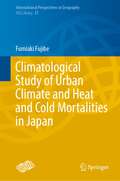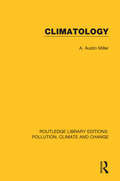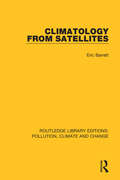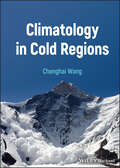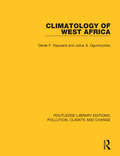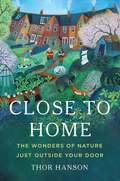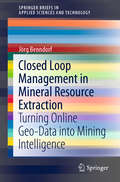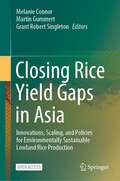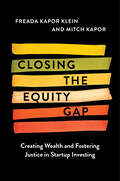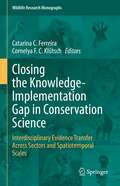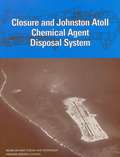- Table View
- List View
Climatic Media: Transpacific Experiments in Atmospheric Control (Elements)
by Yuriko FuruhataIn Climatic Media, Yuriko Furuhata traces climate engineering from the early twentieth century to the present, emphasizing the legacies of Japan’s empire building and its Cold War alliance with the United States. Furuhata boldly expands the scope of media studies to consider technologies that chemically “condition” Earth’s atmosphere and socially “condition” the conduct of people, focusing on the attempts to monitor and modify indoor and outdoor atmospheres by Japanese scientists, technicians, architects, and artists in conjunction with their American counterparts. She charts the geopolitical contexts of what she calls climatic media by examining a range of technologies such as cloud seeding and artificial snowflakes, digital computing used for weather forecasting and weather control, cybernetics for urban planning and policing, Nakaya Fujiko’s fog sculpture, and the architectural experiments of Tange Lab and the Metabolists, who sought to design climate-controlled capsule housing and domed cities. Furuhata’s transpacific analysis offers a novel take on the elemental conditions of media and climate change.
Climatic and Environmental History of Isla de los Estados, Argentina (SpringerBriefs in Earth System Sciences #0)
by Juan Federico Ponce Marilén FernándezThis book is the result of ten years' of scientific research carried out by the authors on Isla de los Estados. The research includes their doctoral thesis and many published scientific papers related to the island. The book is divided into two principal parts. The first part covers different social and natural aspects of this remote island and includes chapters on the scientific and historical background, physiography with topographical and hydrographical descriptions, climate and oceanographic circulation, vegetation and geology (including stratigraphy, structural geology and geological history). The second part comprises a reconstruction of the paleoenvironmental, paleoclimatic and paleogeographic history of the island from the Last Glacial Maximum to the present, correlating with other paleoecological records from the southern part of Isla Grande de Tierra del Fuego and Patagonia. This second part also includes a geomorphological chapter with a characterization of the principal erosive glacial landforms on Isla de los Estados constructed by means of morphometric analysis, inventories, maps, paleogeographic and glacial models, and a paleoecological chapter evaluating the palaeoenvironment and palaeoclimatic conditions that prevailed during the Late Pleistocene-Holocene times based on pollen and diatom analysis from three 14C-dated peat bogs and lakes. Finally, the book concludes with a review of the island's archaeology and the relationship between the palaeoenvironmental history and human occupation of this island.
Climatic and Environmental Threats to Cultural Heritage
by Robyn Sloggett Marcelle ScottClimatic and Environmental Threats to Cultural Heritage examines the challenges that environmental change, both sudden and long-term, poses to the preservation of cultural material. Acknowledging the diversity of human cultural heritage across collecting institutions, heritage sites and communities, the book highlights how, in Australia, Southeast Asia and the Pacific, the quest to preserve such precious knowledge relies on records and narratives being available to inform decisions now and into the future. Bringing together a diverse range of stakeholders who have an interest in – and responsibility for – the care of cultural heritage material and places of cultural heritage value, the book explores their thinking on and actions in relation to issues of climate change and environmental risk. Sloggett and Scott highlight the stakeholders’ shared interest in drawing on their expertise to meet the challenges that environmental change brings to the future of our cultural heritage and our cultural identity. Based on the understanding that this global challenge requires local, national and international co‐operation, the book also considers how local knowledge can have international application. Climatic and Environmental Threats to Cultural Heritage will be of interest to those engaged in the study of heritage, conservation, archaeology, archives, anthropology, climate change and the environment. It will also be useful to practitioners and others attempting to understand the effect of environmental change on cultural heritage around the globe.
Climatological Study of Urban Climate and Heat and Cold Mortalities in Japan (International Perspectives in Geography #21)
by Fumiaki FujibeThis book describes observed features of urban climate and its long-term variations as well as the relationship of climate to heat stroke in Japan, based on observational data and statistical analyses. Consisting of three parts, the book is a valuable resource for researchers and professionals involved with these topics. Part 1 focuses on urban climate. The basic characteristics of heat islands are reviewed, and long-term urban warming is described with a focus on the distinction from global warming. The influence of microscale environmental changes on the observed temperature is also presented, as well as changes in wind and precipitation in urban areas. They deepen our understanding of the features and mechanisms of urban heat islands and their long-term changes. Part 2 describes the climatological features of heat stroke mortality, which has become a major social problem in Japan, using mortality statistics and meteorological data. The spatial and temporal variations of heat stroke mortality are analyzed quantitatively on various spatial and temporal scales. In addition, the number of ambulance transports is examined as another measure of heat stroke casualty. The results provide insight into the climatological factors related to heat stroke mortality and contribute to the implementation of preventive measures. The climatology of deaths from extreme cold is also presented. For supplementary information, an overview of the geography, climate, and meteorological data of Japan is presented in Part 3.
Climatology
by A. Austin MillerOriginally published in 1931 (this re-issues the 8th edition of 1953), this book gives students a comprehensive account of global climatic types and the impact of climate on economics, issues of race, health, meteorology and geography. Climate change is covered from earliest times up until the middle of the twentieth century. The material is supplemented with 82 black and white maps/diagrams.
Climatology from Satellites
by Eric BarrettOriginally published in 1974, was a pioneering study which summarized, within the pre-existing framework of atmospheric knowledge, the more significant findings that emerged from the first decade of climatological analyses of meteorological satellite data. It shows how these data complement and extend the traditional coverage of climatology. The book draws together in one volume research findings which were not previously available in book form and which significantly improve the understanding of climate, especially in regions that were conventionally data-remote.
Climatology in Cold Regions
by Chenghai WangClimatology in Cold Regions A groundbreaking interdisciplinary study of cold-region weather systems and their vital role in predicting climate change across the globe Climatology in Cold Regions explores the complexities of land−atmospheric interaction across the Earth’s cryosphere, systematically placing soil thawing, snow melting, surface diabatic heating, and other processes within the context of broader climatological models. Drawing from a wealth of new data, leading atmospheric scientist Chenghai Wang illustrates how cold-region weather systems can be parameterized to improve seasonal climate prediction and provide crucial insights into projected changes in climate over the next 50-100 years. The book opens with an introduction to the characteristics and classification of cold-region climatology, followed by a detailed description of the primary weather systems and land surface processes in cold regions. The core of the book presents a new approach for seasonal climate prediction using signals obtained from cryospheric processes, supported by a discussion of climate disasters and the impact of climate change on the ecology of cold regions. Introduces a new way of modeling climate in cold regions Offers novel approaches for assessing climate signals from cold regions in seasonal and sub-seasonal predictions Presents new data on the role of cold-region climatology in forecasting and driving global temperature changes Discusses the role of cold regions as the main source of global freshwater supply A significant contribution to climate research and beyond, Climatology in Cold Regions is essential reading for students, scientists, and researchers in the atmospheric sciences, meteorology, ecology, hydrology, and Earth sciences.
Climatology of West Africa
by Derek F. Hayward Julius S. OguntoyinboOriginally published in 1987, this book brings together information previously buried in specialist sources and makes it available to the student in a non-technical and well-illustrated synthesis. It builds a clear and detailed picture of the climates of West Africa, describing and explaining them and showing how crucial this understanding is to everyday life. The climate’s relevance to water resources, agriculture, health and industry is systematically considered.
Clinical and Biomedical Engineering in the Human Nose: A Computational Fluid Dynamics Approach (Biological and Medical Physics, Biomedical Engineering)
by Jiyuan Tu Kiao Inthavong Narinder Singh Eugene WongThis book explores computational fluid dynamics in the context of the human nose, allowing readers to gain a better understanding of its anatomy and physiology and integrates recent advances in clinical rhinology, otolaryngology and respiratory physiology research. It focuses on advanced research topics, such as virtual surgery, AI-assisted clinical applications and therapy, as well as the latest computational modeling techniques, controversies, challenges and future directions in simulation using CFD software. Presenting perspectives and insights from computational experts and clinical specialists (ENT) combined with technical details of the computational modeling techniques from engineers, this unique reference book will give direction to and inspire future research in this emerging field.
Close Encounters of Art and Physics: An Artist's View
by Laura PesceClose Encounters of Art and Physics is a voyage in time through the abstract ideas harboured in the minds of humans, starting from the graffiti art of cave dwellers and extending to the street art of contemporary men and women. In seeking parallels with science, the author looks far back to the first geometric ideas of our ancestors as well as ahead to the contemporary science of present-day physicists. The parallelism and analogies between these two fields bear witness to a real entanglement in the human brain. The second part of the book contains about 25 colour images showing the author's stunning glass artwork representing ideas such as dark matter, quantum entanglement, cellular automata and many others that are almost impossible to capture in words. Furthermore, many of the physicists who have themselves made major contributions in these fields provide their comments and analysis of the works. The book provides entertaining and informative reading, not only for practicing artists and physicists, but also anyone curious about art and physics.
Close Reading the Anthropocene
by Helena FederReading poetry and prose, images and art, literary and critical theory, science and cultural studies, Close Reading the Anthropocene explores the question of meaning, its importance and immanent potential for loss, in the new geological epoch of the Anthropocene. Both close reading and scientific ecology prioritize slowing down and looking around to apprehend similarities and differences, to recognize and value interconnections. Here "close" suggests careful attention to both the reading subject and read "object." Moving between places, rocks, plants, animals, atmosphere, and eclipses, this interdisciplinary edited collection grounds the complex relations between text and world in the environmental humanities. The volume’s wide-ranging chapters are critical, often polemical, engagements with the question of the Anthropocene and the changing conversation around reading, interpretation, and textuality. They exemplify a range of work from across the globe and will be of great interest to scholars and students of the environmental humanities, ecocriticism, and literary studies.
Close to Home: The Wonders of Nature Just Outside Your Door
by Thor HansonAn award-winning natural-history writer presents "the perfect mix of science and story" (Sy Montgomery), opening the door to the nature that thrives in our yards, gardens, and parks: "I couldn't put it down" (Doug Tallamy). We all live on nature&’s doorstep, but we often overlook it. From backyards to local parks, the natural places we see the most may well be the ones we know the least. In Close to Home, biologist Thor Hanson shows how retraining our eyes reveals hidden wonders just waiting to be discovered. In Kansas City, migrating monarch butterflies flock to the local zoo. In the Pacific Northwest, fierce yellowjackets placidly sip honeydew, unseen in the treetops. In New England, a lawn gone slightly wild hosts a naturalist's life's work. And in the soil beneath our feet, remedies for everything from breast cancer to the stench of skunks lie waiting for someone&’s searching shovel. Close to Home is a hands-on natural history for any local patch of Earth. It shows that we each can contribute to science and improve the health of our planet. And even more, it proves that the wonders of nature don&’t lie in some far-off land: they await us, close to home.
Closed Loop Management in Mineral Resource Extraction: Turning Online Geo-Data into Mining Intelligence (SpringerBriefs in Applied Sciences and Technology)
by Jörg BenndorfThis book describes an innovative closed-loop concept that allows the feedback of online data from operational monitoring to create mining intelligence. The application of this concept promises significant improvements in economic and environmental key performance indicators for any mining operation.Combining theory with industrial case studies, the book guides readers through this process by providing theoretical background, addressing practical issues related to operational implementation, and illustrating the impact on selected examples. This new concept is presented using the example of a bulk and gold mining application, but is applicable at any mine where grade control is important.The book is of interest to industrial professionals involved in operational monitoring, mining intelligence, and mine planning optimization, as well as to researchers and academics in the field of applied geostatistics.
Closet Space: Geographies of Metaphor from the Body to the Globe (Critical Geographies Ser.)
by Michael P. BrownIs the closet just a metaphor? Closet Space provides a highly original account of the spatial metaphor of "the closet", and is the first geography text to focus on this important issue. Using a variety of research techniques and materials, the book explores the closet through texts including:* the oral histories of gay men in the UK and US* the sexualised landscape of a New Zealand city* the national census of Britain and the US* international travel guides and traveloguesand refers to the work of Butler, Lefebvre and Foucault.
Closing Rice Yield Gaps in Asia: Innovations, Scaling, and Policies for Environmentally Sustainable Lowland Rice Production
by Martin Gummert Melanie Connor Grant Robert SingletonThis open access book contributes not only to the scientific literature on sustainable agricultural development and in particular rice agriculture but also is highly valuable to assist practitioners, projects, and policymakers due to its sections on reducing carbon footprint, agricultural innovations, and lessons learned from a multi-country/multi-stages development project. The scope of the book is conceived as a detailed documentation of the implementation, dissemination, and impact of the CORIGAP project in Sri Lanka, Myanmar, Thailand, China, Vietnam, and Indonesia, with spill-over to Cambodia and the Philippines. It pulls together actionable research findings with the experience of bringing these findings into use. The aim of the book is to provide a wide array of pathways to impact for sustainable rice production in lowland irrigated rice-based agricultural systems. The book is written by local actors of the rice value chain, researchers, and engineers working on a range of best management practices, climate-smart rice production innovations, knowledge translation, and dissemination, as well as decision-making and policy aspects. It is envisioned that the contents of the book can be translated into messages that can help farmers, extension workers, policymakers, and funders of agricultural development, decide on implementing best management practices and climate-smart technologies in their agroecological systems by presenting the technological/practical options along the rice value chain and the partnerships and business models required for their implementation. The book is aimed at practitioners, extension specialists, researchers, and engineers interested in information on current best management practices, sustainable, and climate-smart rice production and constraints that need further investigation. Furthermore, the book is also aimed at policymakers and agricultural development funders required by public opinion and legally binding agreements to reduce greenhouse gas emissions, conserve biodiversity and increase agroecological practices, who are looking for research-based evidence to guide policymaking and implementation.
Closing the Equity Gap: Creating Wealth and Fostering Justice in Startup Investing
by Freada Kapor Klein Mitchell KaporA social activist and an entrepreneur remake the future of investing and business, offering a win-win road map for creating wealth and addressing inequalities by investing in groundbreaking tech companies that defy assumptions from Silicon Valley to Wall Street.Companies backed by venture capital drive the U.S. economy, accounting for hundreds of billions of dollars in sales and profits. The problem is that most of the wealth created winds up enriching elites, while the businesses funded by venture capitalists widen economic inequality. Committed to doing things differently, tech venture capitalists Freada Kapor Klein and Mitch Kapor launched Kapor Capital to prove that investing in gap-closing startups—companies whose services or products close opportunity gaps for both communities of color and low-income communities—is good business. Over the past decade, they’ve broadened the definition of success to include profits and accountability for the impacts a business has on employees, communities, and the planet, helping to launch close to two hundred companies engaged in achieving social and economic justice while showing remarkable growth, with many valued in the hundreds of millions or billions of dollars.Like every VC firm, Kapor Capital has experienced high-profile blowups and total losses. But its investing principles have created a stunning new ecosystem of Black and Latinx entrepreneurs, CEOs, and investors, all devising innovative, effective solutions to address the most pernicious problems afflicting many of America’s poorest communities. In Closing the Equity Gap, Freada and Mitch share their core belief that all companies must make a positive impact and that the obstacles entrepreneurs overcome in life are a far better predictor of long-term success than the schools they attend or investment dollars they raise from friends and family. Using stories behind some of the most remarkable companies ever launched, they show that the standard investment model doesn’t work, how it can be fixed, and what the future could look like if more investors joined them.
Closing the Knowledge-Implementation Gap in Conservation Science: Interdisciplinary Evidence Transfer Across Sectors and Spatiotemporal Scales (Wildlife Research Monographs #4)
by Catarina C. Ferreira Cornelya F. C. KlütschThis book aims to synthesize the state of the art on biodiversity knowledge exchange practices to understand where and how improvements can be made to close the knowledge-implementation gap in conservation science and advance this interdisciplinary topic. Bringing together the most prominent scholars and practitioners in the field, the book looks into the various sources used to produce biodiversity knowledge - from natural and social sciences to Traditional Ecological Knowledge and Citizen Science - as well as knowledge mobilization approaches to highlight the key ingredients that render successful conservation action at a global scale. By doing so, the book identified major current challenges and opportunities in the field, for different sectors that generate, mobilize, and use biodiversity knowledge (like academia, boundary organizations, practitioners, and policy-makers), to further develop cross-sectorial knowledge mobilization strategies and enhance evidence-informed decision-making processes globally.
Closure And Johnston Atoll Chemical Agent Disposal System
by Committee on Review Evaluation of the Army Chemical Stockpile Disposal ProgramJohnston Atoll Chemical Agent Disposal System (JACADS), the first fully integrated chemical agent disposal facility, is located on Johnston Island some 800 miles southwest of Hawaii. JACADS completed ten years of operations in November 2000, which resulted in the disposal of more than 2000 tons of nerve and mustard agents. In 1998, the Army began planning for closure and dismantling of the facility. In 1999, the NRC was asked to review the Army's planning. This book presents an assessment of planned and ongoing closure activities on Johnston Island in some detail. It also provides an analysis of the likely implications for closure of disposal facilities at eight continental U. S. storage sites.
Cloud Computing for Geospatial Big Data Analytics: Intelligent Edge, Fog And Mist Computing (Studies in Big Data #49)
by Himansu Das Rabindra K. Barik Harishchandra Dubey Diptendu Sinha RoyThis book introduces the latest research findings in cloud, edge, fog, and mist computing and their applications in various fields using geospatial data. It solves a number of problems of cloud computing and big data, such as scheduling, security issues using different techniques, which researchers from industry and academia have been attempting to solve in virtual environments. Some of these problems are of an intractable nature and so efficient technologies like fog, edge and mist computing play an important role in addressing these issues. By exploring emerging advances in cloud computing and big data analytics and their engineering applications, the book enables researchers to understand the mechanisms needed to implement cloud, edge, fog, and mist computing in their own endeavours, and motivates them to examine their own research findings and developments.
Cloud Security: Concepts, Applications and Perspectives (Cyber Ecosystem and Security)
by Brij B GuptaCloud computing is an indispensable part of the modern Information and Communication Technology (ICT) systems. Cloud computing services have proven to be of significant importance, and promote quickly deployable and scalable IT solutions with reduced infrastructure costs. However, utilization of cloud also raises concerns such as security, privacy, latency, and governance, that keep it from turning into the predominant option for critical frameworks. As such, there is an urgent need to identify these concerns and to address them.Cloud Security: Concepts, Applications and Perspectives is a comprehensive work with substantial technical details for introducing the state-of-the-art research and development on various approaches for security and privacy of cloud services; novel attacks on cloud services; cloud forensics; novel defenses for cloud service attacks; and cloud security analysis. It discusses the present techniques and methodologies, and provides a wide range of examples and illustrations to effectively show the concepts, applications, and perspectives of security in cloud computing. This highly informative book will prepare readers to exercise better protection by understanding the motivation of attackers and to deal with them to mitigate the situation. In addition, it covers future research directions in the domain. This book is suitable for professionals in the field, researchers, students who are want to carry out research in the field of computer and cloud security, faculty members across universities, and software developers engaged in software development in the field.
Cloud Structure and Distributions over the Tropical Pacific Ocean
by Herbert Riehl Joanne S. MalkusThis title is part of UC Press's Voices Revived program, which commemorates University of California Press’s mission to seek out and cultivate the brightest minds and give them voice, reach, and impact. Drawing on a backlist dating to 1893, Voices Revived makes high-quality, peer-reviewed scholarship accessible once again using print-on-demand technology. This title was originally published in 1964.This title is part of UC Press's Voices Revived program, which commemorates University of California Press’s mission to seek out and cultivate the brightest minds and give them voice, reach, and impact. Drawing on a backlist dating to 1893, Voices Revived</DIV
Cloud Warriors: Deadly Storms, Climate Chaos—and the Pioneers Creating a Revolution in Weather Forecasting
by Thomas E. WeberThe unprecedented inside story of the people pushing boundaries of science and technology to build better weather forecasts—providing life-saving warnings and crucial intelligence about nature’s deadliest threatsKiller tornadoes. Catastrophic hurricanes. Lethal heat waves. Across the United States and around the world, extreme weather events bring an unending torrent of death and destruction. One indispensable tool consistently offers the ability to help reduce the impact of these calamities: the weather forecast. For centuries, humans have sought to foretell nature’s next moves, from ancient farmers to trailblazers of the Space Age, who brought computers and satellites to bear on the problem. Now a new wave of advances, including artificial intelligence and data-gathering drones, makes it possible to accurately detect these fearsome events further in advance. They provide critical time to prepare and get people out of harm’s way—an undertaking made ever more urgent by the effects of climate change.In a remarkable tale of innovation and perseverance, veteran journalist Thomas E. Weber takes readers into the world of the pioneers creating these game-changing forecasts. From storm chasers racing to hunt twisters and physicists unraveling the secrets of the atmosphere, from scientists studying how people react to warnings to humanitarian groups rushing to avert famines, Weber goes behind the scenes to show how predictions keep getting better. He explains what’s needed to turn these forecasts into actions that prevent tragedies and how anyone can become more weather literate to protect themselves in emergencies. Cloud Warriors will change the way you think about treacherous weather—and the power of being able to see it coming.
Cloud and Precipitation Microphysics: Principles and Parameterizations
by Jerry M. StrakaThis book focuses specifically on bin and bulk parameterizations for the prediction of cloud and precipitation at various scales - the cloud scale, mesoscale, synoptic scale, and the global climate scale. It provides a background to the fundamental principles of parameterization physics, including processes involved in the production of clouds, ice particles, liquid water, snow aggregate, graupel and hail. It presents full derivations of the parameterizations, allowing readers to build parameterization packages, with varying levels of complexity based on information in the book. Architectures for a range of dynamical models are given, in which parameterizations form a significant tool for investigating large non-linear numerical systems. Model codes are available online at www.cambridge.org/9780521883382. Written for researchers and advanced students of cloud and precipitation microphysics, this book is also a valuable reference for all atmospheric scientists involved in models of numerical weather prediction.
Cloud-Resolving Modeling of Convective Processes (Springer Atmospheric Sciences)
by Xiaofan Li Shouting GaoThis is an updated and revised second edition of the book presenting new developments in the field of cloud-resolving modeling. The first edition of the book introduces the framework of cloud-resolving model, methodologies for analysis of modeling outputs, and validation of simulations with observations. It details important scientific findings in the aspects of surface rainfall processes, precipitation efficiency, dynamic and thermodynamic processes associated with tropical convection, diurnal variations, radiative and cloud microphysical processes associated with development of cloud clusters, air-sea coupling on convective scales, climate equilibrium states, and remote sensing applications. In additional to the content from the first edition of the book, the second edition of the book contains the new scientific results in the development of convective-stratiform rainfall separation scheme, the analysis of structures of precipitation systems, the thermal effects of doubled carbon dioxide on rainfall, precipitation predictability, and modeling depositional growth of ice crystal. The book will be beneficial both to graduate students and to researchers who do cloud, mesoscale and global modeling.
Clouds (Let's Read and Find Out Science)
by Anne Rockwell Frané LessacDo you ever wake up and wonder what the weather will be? Instead of turning on the TV to find out, you can just look out your window at the clouds. How do you know what type of clouds can forecast a change of weather? Read and find out.



